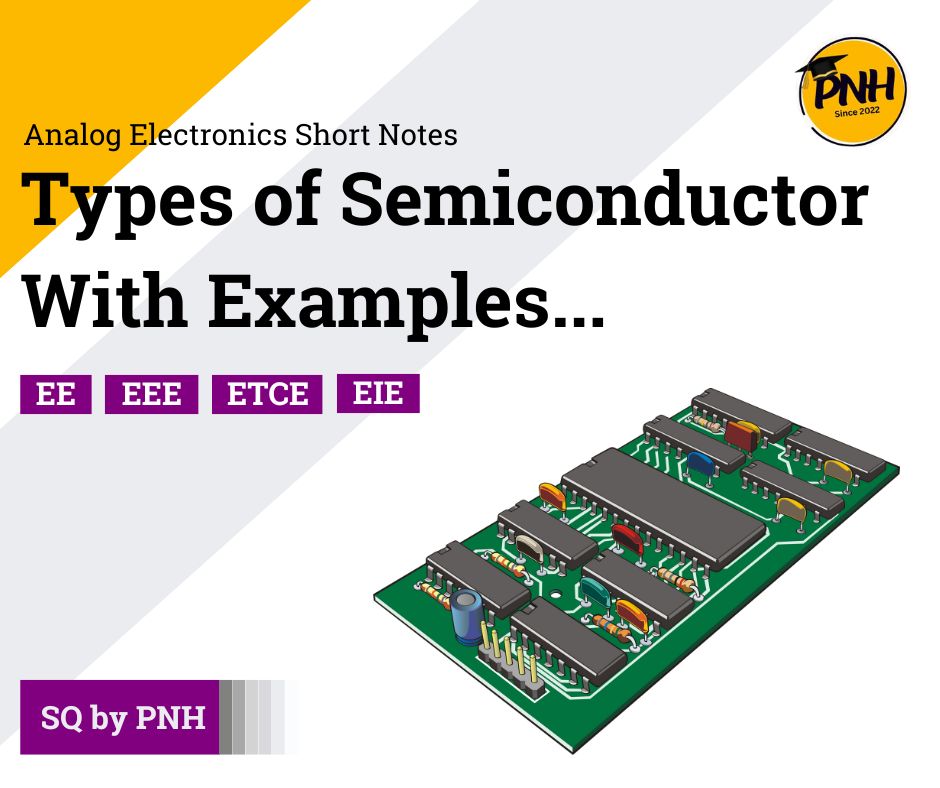In this blog, we are going to explore the topic called “Types of Semiconductor.” Welcome to Poly Notes Hub, a leading destination for engineering notes for diploma and degree engineering students.
Types of Semiconductor
Semiconductors are materials that have a conductivity level between conductors and insulators. They form the backbone of modern electronics, from computers to smartphones. Understanding the different types of semiconductors is key to comprehending their applications and functionalities in various technological fields.
Intrinsic Semiconductors
Intrinsic semiconductors are pure forms of semiconductor materials, such as silicon and germanium. These materials have no impurities and rely solely on their atomic structure for conduction. At room temperature, intrinsic semiconductors generate a small number of free electrons and holes due to thermal energy, allowing them to conduct electricity at a moderate level.
- Key Characteristics:
- Pure and unaltered.
- Conductivity depends on temperature.
For more details, you can explore Wikipedia’s page on Intrinsic Semiconductors.
Extrinsic Semiconductors
Extrinsic semiconductors are formed by adding impurities, a process known as doping, to intrinsic semiconductors. This doping process significantly enhances their electrical conductivity. Based on the type of impurity added, extrinsic semiconductors are divided into two categories:
- N-Type Semiconductors
- Doped with elements that have more valence electrons than the semiconductor material (e.g., phosphorus or arsenic in silicon).
- Free electrons act as charge carriers.
- P-Type Semiconductors
- Doped with elements that have fewer valence electrons (e.g., boron or gallium in silicon).
- Holes (positive charge carriers) dominate the conduction process.
To learn more, visit Poly Notes Hub, where you’ll find comprehensive engineering notes.
Compound Semiconductors
Compound semiconductors are made from two or more elements, such as gallium arsenide (GaAs) or indium phosphide (InP). These materials are used in high-frequency and optoelectronic devices like LEDs, laser diodes, and solar cells due to their superior electron mobility and light-emitting properties.
- Key Applications:
- High-speed communication devices.
- Optoelectronics.
Organic Semiconductors
Organic semiconductors are composed of carbon-based molecules or polymers. These materials are lightweight, flexible, and cost-effective, making them suitable for applications in flexible electronics, organic LEDs (OLEDs), and organic photovoltaic cells.
Applications of Different Types of Semiconductors
Each type of semiconductor has unique properties that make it suitable for specific applications:
- Intrinsic Semiconductors: Used in research and development to study fundamental properties.
- Extrinsic Semiconductors: Widely used in diodes, transistors, and integrated circuits.
- Compound Semiconductors: Ideal for high-performance and optoelectronic applications.
- Organic Semiconductors: Emerging technology for flexible displays and solar panels.
For additional insights, check out the detailed Wikipedia article on Semiconductors.
Conclusion
The “Types of Semiconductor” play a crucial role in advancing technology. From intrinsic to compound semiconductors, each type offers unique capabilities that drive innovation across industries. For more detailed resources, don’t forget to visit Poly Notes Hub, your ultimate platform for engineering notes.
Stay tuned to Poly Notes Hub for more educational content and updates on cutting-edge topics!

